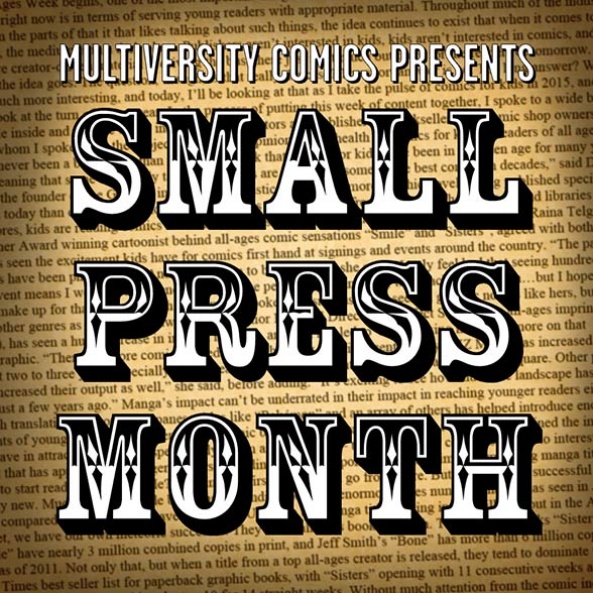
Today’s installments of Small Press Month will focus on the different ways people look at indie publishers. Last week, I wrote about how I was defining the small press for this series. I like to think the labels I applied to various groups were well reasoned, but the truth is they’re still somewhat vague, arbitrary, and little more than my opinion. Since my opinion isn’t the only one that matters, I reached out to two other Multiversity cohorts – Vince Ostrowski and Cassie Clark – to see if they felt the same way I did. Later today, we’ll also have a reader poll so you can weigh in and see how your viewpoints stack up against other Multiversity readers.

Drew: If we’re going to talk about small press books, the first thing we should do is make sure we’re talking about the same thing. What publishers or titles came to mind when I asked you do this piece, and where do you draw the line between small press and whatever’s above that?
Vince: When I think of the phrase “small press”, I think of anything that doesn’t fall under the banners of DC Comics, Marvel, Image, Dark Horse, Dynamite, and IDW. I hope I didn’t miss anything there.
I admit that drawing the line there is flawed. After all, Dynamite’s operation has its own little creator-owned prestige wing that puts out stuff like “Terminal Hero”, so it’s not all classic pulp properties that it needs to hang on to the publishing rights for. At the same time, I left Boom! out of the considerations for big time publishers, even though a decent chunk of their publishing line is comic book versions of contemporary animated cartoon properties. I left out Archie, as well, even though I’m fairly certain that not a single thing they put out is creator-owned. They are dealing entirely in IP. I’m starting to feel like I should be including those.
But I don’t think we’re necessarily strictly talking “creator-owned” here, are we? I think we’re talking the size of the operation. You can correct me if I’m wrong about that. Feel free to also correct me if I have a skewed perception of any of the types of publishers we’re going to talk about.
Foremost, I think of the small press publishers that basically only exist to put out a single creator’s work and not much else. I’m thinking of Aardvark for Dave Sim, Abstract for Terry Moore, Bergen Street for Michel Fiffe, etcetera. These are the smallest of the small. Creators that have the clout, goodwill, and following to support an intimate relationship with a publisher or publish pretty much on their own account.
Then I expand a little and think about burgeoning publishers like Black Mask, ComixTribe, First Second, or Action Lab – these guys and gals put out several comics from a variety of creators, but they’re smaller time operations and are more “curated”, so to speak, than your larger publishers. They’ve got less resources, and they’re generally careful about how they use them.
Would you include something like Bongo, which exists only to put out Matt Groening’s various IP? Do you include prestige publishers like Drawn & Quarterly or Fantagraphics? I think I would, personally. They don’t get nearly enough attention. Well, at least until awards season comes around.
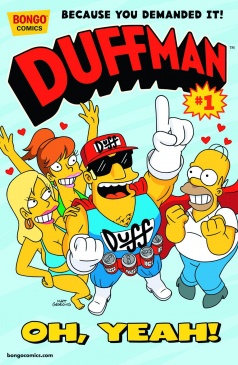
Drew: You take a much broader view of small press than I do, Vince. I usually cut the comic market into four parts: The premiere five publishers (Dark Horse, DC, IDW, Image, Marvel), the middle weights (Avatar, Boom, Dynamite, Oni, Titan, Valiant, Viz, and Zenoscope), the small (all the publishers in the green pages of “Previews” who don’t warrant their own special section), and the micro (the ones too small to be in “Previews”). I don’t really figure the IP ownership into it all, since all the publishers dabble in creator ownership somewhat.
I’d count Bongo as small, but as a Bongo fan I feel the need to point out they’re not just Matt Groening properties anymore. They’ve got a Spongebob book, and they’ve done books like “Heroes Anonymous” and “Mylo Xyloto.”
Continued belowCassie: I primarily think of small vs. large press based on their capital, or press-power, or MONIES. It’s kind of a marketing approach to it but the reason I consider the “Big 2” to be a large press is because they have large resources. So, I find it tricky to call “Image” and “Dark Horse” in their category as they do not (although thanks to some TV show rights and also movie rights the two have seen more money turned their way to give them more resources in the market) have nearly as much funds to classify them on that level of press-power.

My own tier kinda works like this: 1.) Marvel and DC (the untouchables), 2.) Dark Horse, IDW, Image, Dynamite, 3.) Boom (though I think this too will soon change as they are now reverting to movie and TV titles to gain following and also funding) Drawn & Quarterly, Fantagraphics, Top Shelf Productions, First Second (they are partnered by TOR and Picador and St. Martin’s Press to really help fund beautiful work and call on people like Cory Doctorow to get stuff done), 4.) Black Mask, ComixTribe, Action Lab…
If someone was to ask me of a small-press in an expectation of what is not “Big 2” releases, I will admit my first thought is to refer to Tier #2 and Tier #3 for suggestions. There’s not really a rhyme or logic to it so much as those are the publishers that I consider “smaller” net-worth wise, but also to be doing some interesting and fun things that the largest tier do not do, and do not promote. If someone pushed me into a corner and made me choose what I considered to be small-press content-wise (which is a crazy question as it does show some of my own bias as a reader) I’d say my Tier #3. I’d say that I’m pretty unaware of the happenings of Tier#4.
Drew: Interesting! I expected we’d have our own view of these things, but I honestly didn’t expect them to be quite so different. Before we go on, we should probably agree to a general line. I think Cass’s tiers 3 & 4 probably cover a wide enough swath to make us all happy. Sound good?
Cassie: Cool with me!
Vince: Yes!

Drew: With that in mind then, let’s talk about the small press books we’re reading.
Depending on the month, somewhere between a half and a third of my pull comes from the small press. Between irregular schedules, miniseries, and OGNs, the exact number fluctuates a lot.
Two that’ve really caught my attention recently are “Annie Bonnie,” a pirate adventure/fantasy from Blue Juice, and “Zoo Hunters,” a surprisingly emotional sci-fi story a father-son animal catching team.
The others I’m reading (in alphabetical order by publisher) are “Rachel Rising”, “Pirate Eye”, “Sesame Street”, “Black Hood”, “Sabrina”, “Accelerators”, “The Woods”, “Cluster”, “Deep State”, various “Simpsons” books, “Futurama”, “Helheim”, “Separators”, “Ichabod Azrael”, “Divinity”, “Rai”, “The Valiant”, “Doctor Mirage”, and “Bleach”. I also read “Sixth Gun”, “Wasteland”, and “Afterlife with Archie” in trade, along with occasional OGNs from Slave Labor, Top Shelf, or First Second.
And I feel I should mention I only read one book between Marvel and DC, which may explain why small press makes up such a large portion of my pull.
What are you two reading, and what are the real standouts for you, and why do you like them so much?
Vince: My pull list doesn’t favor small press as much, but it’s only because I read far more Marvel and DC than any human being should. I actually need to trim down on that habit, because I’m reading a lot of stuff from both companies that I’m not enjoying as much as I should be.
I can’t say the same about my pull list from a small press standpoint. Everything I read, because it’s such a tight, curated selection, is something I thoroughly enjoy. I’m not going through the motions, because I’m reading these books for a different reason. I read Marvel and DC, sometimes, just to keep up. That’s a terrible reason to read something, but it is what it is.
Continued below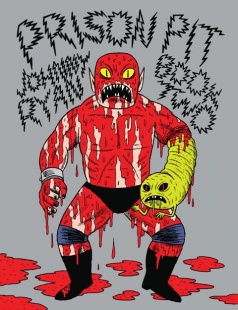
The small press book that I trumpet more than any other is “Rachel Rising” from Terry Moore and Abstract. I think what attracts me most to the idea of reading small press stuff is how intimately involved the creator is in all steps on the process. When I pick up “Rachel Rising”, I feel like I’m supporting the artist more than any other time I pick up a comic from the shop. Not only that, but it’s one of the highest quality comics I read week in and week out. It’s as creepy, mystifying, and compelling as anything else I read. I’m not a big buyer of original art or comic prints. I just don’t find much value in that and it takes a lot for me to make an exception. But when I buy a book like “Rachel Rising”, it’s a no-brainer financial commitment and it’s the reason the artist does what he or she does. Another attractive aspect is the fact that Terry Moore is the writer-artist. The comic that I hold in my hand comes primarily, if not entirely, from the mind and talents of one person.
I also read “Prison Pit”, “Lose” by Michael DeForge, and anything Daniel Clowes, Jeff Smith, Derf Backderf, or Charles Burns puts out – all for the same reasons. I love taking chances on small press and independent stuff because the rewards are far more esoteric and surprising than rewards that come from something with a lot of media recognition or blog support. That’s how I discovered “Copra” from Michel Fiffe – which is one of my favorite current comics. I took a chance on it one day, out of the blue, and couldn’t believe what I found.
Basically, I tend to find the quality of these books to be high, find it incredibly rewarding to be surprised by them, and feel good about what my purchase of these comics represents for the creators.

Cassie: Not enough. “Rachel Rising” is slowly smoldering on my pull list, but am currently in love with “Tippy and the Night Parade” a children’s graphic novel drawn by Lilli Carre, the “Sunny” volumes by Taiyo Matsumoto, and SHOWA 1944-1953: A History of Japan. Oh, and I have been slobbering over “Beautiful Darkness” by Fabien Vehlmann and Kerascoet for too long. I tend to be more whimsical when I pick up smaller press books (read: small press graphic novels) as I like to save up for the hardcovers and read them again, and again. Weeklies or serial editions of books are easy to draw me in quickly, and usually my interest will taper off when creators switch and visions are changed (with the exception of some X-Men titles) and tend to eventually run their course for me. So overall I probably spend less time researching small presses than happily discovering titles that I will let fester in my brain forever. “In Real Life” by Cory Doctorow and Jen Wang was probably my favorite release this year from the smaller press/graphic novel front.
Drew: I occasionally pick up new books by impulse buy or through good word of mouth, but nearly all of my purchase decisions are made when I look through Previews. A big reason for that is my LCS doesn’t stock much small press unless someone pre-orders a copy. That essentially means that if I don’t order it, it won’t be there for me to browse and buy later.
I do my best to read all the solicitations so I don’t miss something interesting, but there are a few publishers I’ve learned to skip after some bad experiences. By far, I find the most important factor in drawing my attention is a good cover or title. It’s a lot harder for solicitation text to pique my interest if the cover art looks awful, but an attractive cover can earn some leniency for a poor solicitation.
What is it about a new small press book that makes you guys give it a shot?

Vince: First and foremost, is the creator. If it’s someone I’ve trust, whose work I’ve seen and enjoyed before, I buy it sight unseen. However, when you’re talking about small press and new series, it’s a rarity that the creator has all that much work under their belts. Longstanding creators like Terry Moore and Jeff Smith, who primarily operate by carrying themselves, are rarely in the public eye. It’s more often that I’m taking a chance on someone newer and less tested. I find that, more often than not, I’m attracted to an artist’s work on a blog, website, or another medium. One of the common things I take a chance on are comics or art books from artists that are primarily known for gallery work, installations, and the like. I probably buy one or two art books or comics from artists like these every month. Artists like DeForge, who maybe put out a book or three each year, frequently get my money.
Continued belowIf you’re asking what I look for when I take a chance on work that I’m entirely familiar with, I have to be honest and say that a solicitation doesn’t do a lot for me. Interior art goes a long way toward getting me to check something out, but I am loathe to reading previews and spoiling 1/4 of a comic for myself so I try to see as little as possible before making a decision. The cover and the graphic design of the physical comic itself can go a long way too. If the cover looks great, whether it represents what to expect from the interior art or is an attractive minimalist approach, a good cover gets me to look closer. And a good paper stock with an attractive packaging tells me that, even though its’ small press, these creators (and the publisher) are serious about it.
My number one strategy for determining whether I’m going to pick up a new small press title is to search out the creators and get a sense of their work. Familiarize myself with their sensibilities and their aesthetic, without spoiling too much. I usually google the names involved and look at their past works, especially when it comes to the art. I love pouring over small time creators’ blogs and finding out if I’m interested in seeing more.
Drew: You put a lot more effort into researching books before buying them than I do. Are you usually doing this before the number one (or volume one) drops, or are you tracking down copies after their release?
Vince: Both! But because I scour previews every month to do my planning, it’s usually before the first issue or volume drops. However, I have been known to let stuff slip through the cracks, and then I rely on the fine folks I write with (like you) to recommend stuff I may have missed.
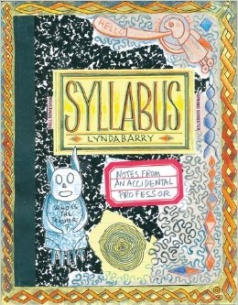
Cassie: I look for small press books that take risks. I really love concept-driven pieces, or collections targeted at taking an old genre idea and flipping it on its head. I also tend to read small presses that favor a higher percentage of art than words. Presses like Drawn & Quarterly always amaze me with how their works seem to unite words and art in a way that often makes the artist part letterer and part writer and part visionary. I also like when the work is part-memoir, part-confessional. Lynda Berry’s latest work “Syllabus: Notes from an Accidental Professor” is a great example of a work that kinda tackles all the things that I look for in a small press read (or should I just read, that happens to be found more often in small presses): risks, defying convention, hilarity, realistic, and visually stunning.
Drew: ” part-memoir, part-confessional”? Oh, Cassie, please tell me you’ve read Craig Thompson’s “Blankets.” It sounds right up your alley.
And you say you find most of the ones you like by browsing? I take it that means you’ve got a nice, diverse comic shop. The one I shop at has more variety than some I’ve been to, but most of the time I find it’s a generic type of diversity, if that’s possible. It’s mostly indies that are (or were at one time) the more popular ones.
Ok, so now that we all know what the others are reading, let me ask you this: Do you judge small press books the same way you do mainstream books, or do you hold them to different standards. Stating it a different way, Imagine if Marvel and Miscellaneous Publisher both have a $3.99 book that are of comparable quality in terms of story, writing, and art. Both books are average to middling. Would you drop them at the same time, or would you be willing to stick with one longer than the other?

Cassie: I think I tend to judge both kind of tales on the same standard. I do think if a Marvel tale changes the creative team, that’s a factor in me saying I’ll pass…but it’s because it’s hard for me to attach to another take on a story if I particularly enjoyed the former version. A good example of this is I’m skeptical to pick up the new Hawkeye because I loved what it was, and a new team will bring in something different. So maybe I should say with mainstream comics I will judge the team’s working togetherness/what else they’ve done that I’ve liked more than the story being told. In a small-press book of marketable same quality (unsure what that means technically haha) and price, I’d most likely look for the story first. This might also be because with small-press books I’m so often finding new creators and have less of a backlog of information on former work they’ve done…which makes the judgment different. So often small-presses are building entirely new stories, too, so it’s less of a “do I like this take on this character or this story” so much as “what about this story hooked me.”
Continued belowI don’t know how fair of an answer that is, but it’s true.
Vince: And by contrast, I tend to stick with the small press books longer. In fact, I won’t name names, but I’ve stuck with books that I didn’t really like – just because I knew I was supporting a creator that I otherwise believed in.
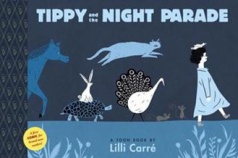
With Marvel or DC, I find it remarkably easy to jump off of a comic that I’m just not liking. With small press, Indie, or even something as large as Image Comics, I tend to stay on the hook longer, even when I’m not crazy about the comic. I think the reasons for that are many. For one, Marvel and DC aren’t going to be hurting because I stopped reading a bad X-Men book, but a small time creator certainly might, down the road. Also, I think an upturn in quality or a surprise twist that enhances the book is more likely from an Indie creator than it is from a Marvel Comics, where the twists are usually superficial or telegraphed far in advance. Similarly, upticks in quality usually happen with creative team changes on Big Two books – not in a natural way. That’s not a bad thing, inherently, but it is something that would get me to check out until the creative run is over and a new writer replaces them. With Indie Comics, there are just a lot more surprises.
Finally, even with a middling Indie title, I can usually see the passion and care that went into it. I really do believe in supporting the work of artists. Lord knows most of them need all the support they can get. With a middling DC Comics book, it’s usually less a matter of passion and heart than a way to make ends meet. That’s not always the case. Hell, it might not even be the case a majority of the time. I wouldn’t know. But those books do feel much less personal, anyway, which is why I find them easier to drop.
Drew: I’m with you, Vince – I’ll stick with an average indie longer, but I have a completely different reason.
I can’t even begin to count the number of series that I was cool on at first, only to warm up to them months or years later. If I’m not crazy about a title that’s selling 50,000+ copies, I don’t have to worry about tracking down missed issues later. If I pass up an indie book with a print run of 5000 or less, I’ll either never see it again or pay an unreasonable sum for it. Of course, I’m still reading comics exclusively in print. This is probably less of a concern for digital readers.
Ok, on to our last topic. As members of the comic press, do you feel any kind of obligation to Multiversity’s readers to read and review books you would otherwise have no interest in?

Vince: You know, when I was a reviewer for the site, yes, I did feel an obligation to review books that I felt wouldn’t get enough attention. But it was a self-imposed obligation and one without regret. I guess where I would deviate from answering your question in the affirmative is that I never once reviewed a book that I didn’t have interest in. I have such wide-ranging interests and such an open mind that almost nothing was off the table though. There is a small handful of publishers I won’t read anything from, because what they make is decidedly not made for me, however.
I tend to find myself more interested in the artist than I am the art. I love to get to know artists through their art. I like discovering the personality of the creator without actually knowing or interacting with them. So even if the subject matter is outside my comfort zone, I find immense satisfaction in getting outside that comfort zone and checking their work out for an issue or two. I tried to do that while I wrote reviews for Multiversity, and I ended up with infinitely more pleasant surprises than duds.
Drew: I’ve also felt a self-imposed duty to look at books off the beaten path. Back when I was still doing the Tradewaiter column, I had a lot of fun digging through the bargain bins for trades I’d never heard of that looked somewhat decent. If they turned out to be good, I’d either write them up or find something more current from the creators. I’m happy to say that doing this broadened my horizons and really changed the make up of my reading list.
Cassie: I only feel obligated to read what I like and promote that for others to find, and enjoy. Chances are, if I find something I don’t like, I will not cover it or want to cover it as much…unless there is something to gain about discussing what it is that is wrong (read: problematic) and what could change (read: progress).






